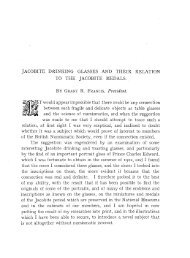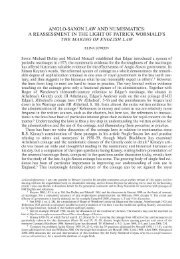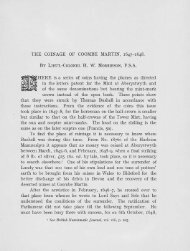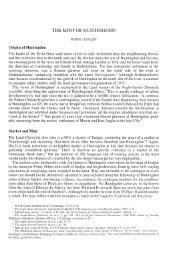Early Northumbrian Coins at Auction, 1981 - British Numismatic ...
Early Northumbrian Coins at Auction, 1981 - British Numismatic ...
Early Northumbrian Coins at Auction, 1981 - British Numismatic ...
Create successful ePaper yourself
Turn your PDF publications into a flip-book with our unique Google optimized e-Paper software.
EARLY NORTHUMBRIAN COINS AT AUCTION, <strong>1981</strong> 33<br />
BOLTON PERCY, 18U?. The Fennell Parcel<br />
The stycas found in the spring of 1847 are the first to have been recorded<br />
from this Yorkshire parish. Accounts 3 of the circumstances of the discovery<br />
given by Charles Wellbeloved of York and by William Fennell of Wakefield<br />
differ considerably. It seems th<strong>at</strong> the workmen who found them divided<br />
the spoils among themselves and each went on to dispose of his share to<br />
others. Wellbeloved, who believed the total to have been three or four<br />
thousand coins, recognized them as being in much worse condition than those<br />
of the York 1842 find and having no trace of a container. He first acquired<br />
about six hundred of them for the Yorkshire Philosophical Society's museum<br />
and subsequently published a summary of th<strong>at</strong> parcel.' 1 Fennell's account<br />
indic<strong>at</strong>es th<strong>at</strong> he visited the site in June of th<strong>at</strong> year, finding a further<br />
sc<strong>at</strong>ter of coins and fragments of le<strong>at</strong>her which he identified as the probable<br />
remains of the hoard container. He also makes it clear th<strong>at</strong> in forming<br />
his own collection, he picked and chose from among those offered to him<br />
by a number of people. This must account for the specimens in his parcel<br />
being, on the whole, in considerably better condition than those examples<br />
from the 1847 find which can now be recognized in the Yorkshire Museum.<br />
Even so, Fennell was not so overpowered by consider<strong>at</strong>ions of condition th<strong>at</strong><br />
he failed to retain, along with a specimen of the le<strong>at</strong>her, two small clumps<br />
of unsepar<strong>at</strong>ed coins. Although neither he nor Wellbeloved had any chance<br />
of examining the total hoard and deciphering the labyrinth of die—links,<br />
both made meticulous manuscript c<strong>at</strong>alogues, noting die varieties. 5 Fennell<br />
retained some die-duplic<strong>at</strong>es but disposed of <strong>at</strong> least one small selection<br />
as is shown by his present<strong>at</strong>ion to Charles Winn. 6 It is not known when<br />
he parted with his main collection.<br />
Fennell's published commentary on his parcel is tinged with a certain<br />
amount of bravura. Since he had had no opportunity of recognizing a distinction<br />
between a well-executed regular coinage and a mass of die-linked<br />
irregular issues, he ascribed the blundering of the l<strong>at</strong>ter to the personal<br />
eccentricities of the ninth-century official moneyers who must have followed<br />
their own whims in the style and detail of the dies. The p<strong>at</strong>terns of the<br />
official coinage and of the contemporary irregulars cannot be determined<br />
from a single parcel; specimens selected partially <strong>at</strong> random produce a distorted<br />
picture. Even the large number of blundered stycas already in the<br />
Yorkshire Museum's cabinet, from York 1842 and from the Bolton Percy finds,<br />
do not demonstr<strong>at</strong>e completely the scale and n<strong>at</strong>ure of imit<strong>at</strong>ion in the York<br />
area. 7 By taking into account a considerable proportion of the relevant<br />
specimens in the Fennell parcel, one can, however, fill in a number of<br />
missing details. It may eventually be possible to establish how many distinct<br />
groups of imit<strong>at</strong>ion exist and how they may be phased chronologically.<br />
It has been said th<strong>at</strong> the composition of the 1847 and the 1967 finds from<br />
Bolton Percy is largely the same in both instances and th<strong>at</strong> the discoveries,<br />
over a century apart, were of components of one and the same initial deposit.<br />
It may r<strong>at</strong>her be th<strong>at</strong> the similarity between the two finds reflects the composition<br />
one ought to expect of any styca hoard recovered in or near the city<br />
of York.<br />
THE WINN COLLECTION<br />
Charles Winn's family had had, in its coin collection, <strong>at</strong> least one styca<br />
- th<strong>at</strong> from Wintringham, 1750 - and possibly some others, obtained well<br />
before the acquisition of further specimens from Hexham 1832, York 1842 and<br />
Bolton Percy 1847, by Charles Winn personally. Some of the groups apparent<br />
in the collection have never been fully documented with provenanced d<strong>at</strong>e



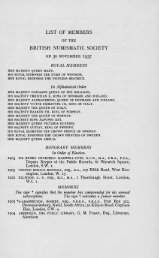

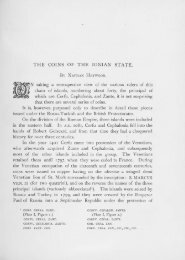
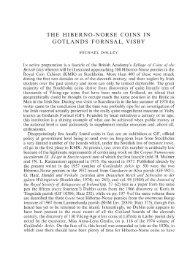
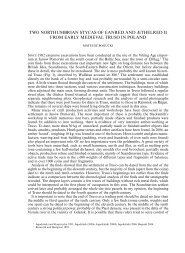
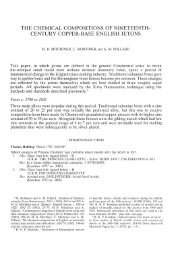
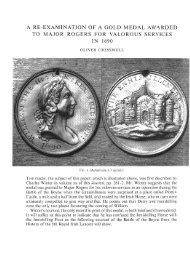
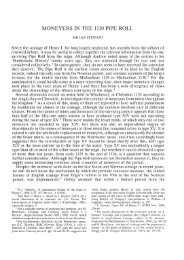
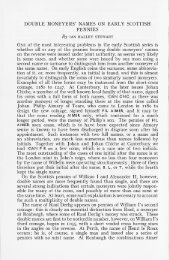
![Two Anglo-Saxon notes: [1] A Cnut die-link between the mints of ...](https://img.yumpu.com/15433998/1/189x260/two-anglo-saxon-notes-1-a-cnut-die-link-between-the-mints-of-.jpg?quality=85)
